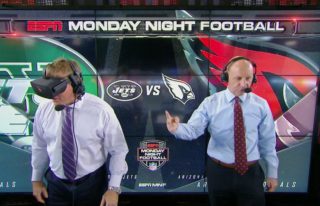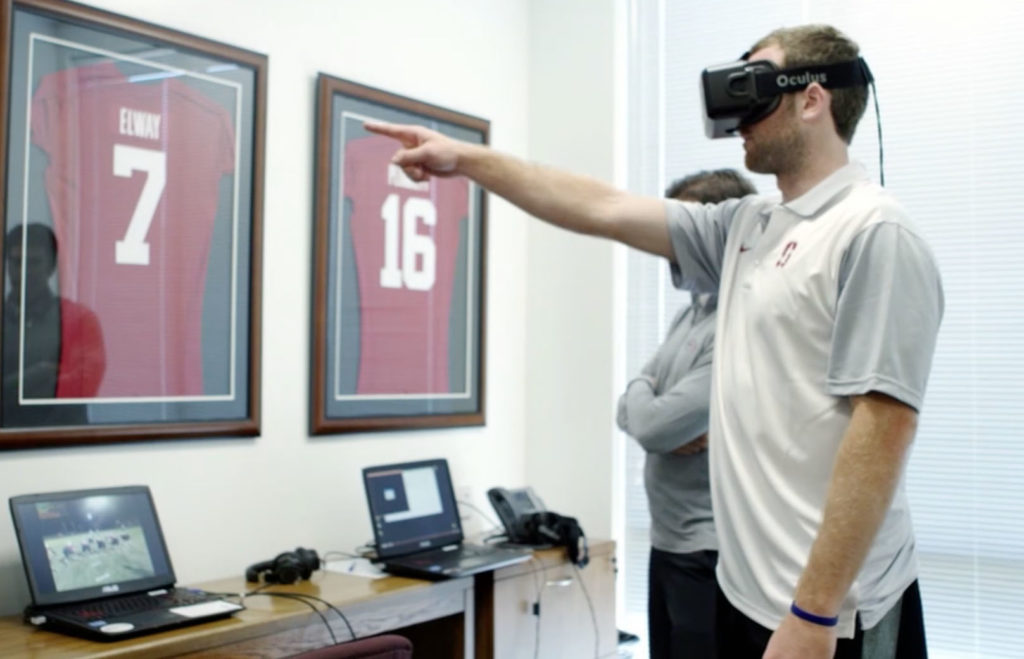Derek Belch is a former Stanford football player and graduate assistant coach for the Cardinal team. During his time at the university, he studied and graduated with a journalism degree and returned to Stanford after attending business school at USC to earn a masters in virtual reality.
Shortly after toiling with the revolutionary and emerging tech in school at the heart of Silicon Valley, Belch founded STRIVR Labs, a VR performance training platform that is aiming to unlock the untapped potential of athletes and businesspeople through practice.

Now the one-time college kicker presides as the CEO for the Palo Alto-based start-up, which has quickly developed into one of Fast Company’s 50 “Most Innovative Companies In The World,” is netting investments from sports icons like four-time Super Bowl winning signal-caller Joe Montana and is working with forward-thinking sports franchises who want to make sure their big-ticket players are in prime position to perform at optimal levels.
Teams like the Dallas Cowboys, a cavalcade of franchise players like Andrew Luck and brands like BMW are lining up to use virtual reality in order to eliminate any blind spots, and improve at their crafts.
“[Former 49ers coach] Bill Walsh used to talk about preparation all the time, and at its core, STRIVR is a preparation tool. Seeing things happen in virtual reality helps prepare you for when those things happen in real life,” Montana said in a statement when his investment was announced in March. “It doesn’t matter if you’re a quarterback or a worker on a factory floor—repetitions are important. STRIVR delivers the ability to get repetition and get experience in a way I haven’t seen before. STRIVR believes in the idea that virtual experiences can impact real world behavior. They are helping people perform better at their jobs, no matter what that job is. The opportunity in front of them is enormous.”
Belch joined AListDaily to shed light on how VR can find a foothold in training brands and sports franchises.
How is STRIVR Labs differentiating itself from other VR companies?
For the last two years, we’ve been doing a mix of training and experiential brand work. We’ll continue to do both because the ecosystem plays into each other. Long term, we want to be a leader in human-performance VR. We’re also currently working behind the scenes with three Fortune 100 companies using VR to train their employees, and almost 25 sports teams.
How are you marketing your platform?
The players don’t like for us to talk too much about what we’ve done, but Arizona Cardinals quarterback Carson Palmer came out in the media and sang our praises on how he’s incorporated VR into his practice routine. Buffalo Bills quarterback Tyrod Taylor talked about it, too. So there’s some stuff out there. I don’t like to be quoted because I don’t want to attribute their success to STRIVR Labs. We’re just one part of it. We do not have any true consumer products or an offering today, but we will eventually. We have done a lot of work with different brands, like Gatorade, Visa, Pepsi, Lowe’s and Bank of America, and how we can use VR as part of their campaigns to put it in front of consumers. Or in-arena activations like a virtual hockey goalie simulator for the Los Angeles Kings, New York Rangers and Washington Capitals. It’s not something we’re selling to put in your living room, but it’s an awesome way for teams to build fan-engagement tools through experiential marketing.
Be the #LAKings goalie with our VR Experience at tonight's game outside of Section 105! pic.twitter.com/DUlNFj4U1a
— LA Kings (@LAKings) January 19, 2017
Why are major sports leagues and franchises trying to solve marketing problems through VR?
It’s a great question. Right now, it’s about staying at the forefront of technology and being viewed as innovative. Studies show that brands are viewed more positively by consumers as a result of using VR, as opposed to just watching something in 2D. Long term, we’ll be able to see how data plays out from tracking where exactly consumers are looking at. . . . We’re very friendly with brands like NextVR, but we do not do what they do. They’re trying to solve the live VR sports broadcast problem, and we’ll see where that goes over the next decade. I could see the VR lines blurring in the long term. They are a complementary component to what we do, and we complement what they do in the VR ecosystem. We talk about them very positively, and vice versa.
Why are sports franchises adopting VR with hopes of changing their fortunes?
We’re still in early adopter mode. There’s a long way to go. Less than a third of the NFL is using it. There are teams that have tapped other companies, too. We anticipate STRIVR Labs’ NFL team count to jump to 10 or 11 this year. I think the idea of using VR to get more reps from a mental standpoint is unequivocally valued across the board. Then the question is, “Do I have to change my current pattern or behavior on-and-off the field to actually integrate this?” A lot of teams just aren’t ready for that. Furthermore, especially at the quarterback position, the best signal-callers are veterans, and have been doing this for a while. They are pencil-and-paper guys. Are they really drawn to VR? Some are, and some aren’t. Over the next few years, as we see a younger wave of players come into the league, you’re going to see VR adopted even more.

The NFL is already using technology with Microsoft Surface tablets on the sideline as the “official tablet and PC operating system of the NFL.” Is digital savvy being welcomed by old school regimes?
From how teams train to the ways in which they call their plays, the NFL is without a doubt a copycat league. VR in the league is something where in five years, it’s going to be everywhere. It just takes some time. You have to remember that until a decade ago, NFL teams were watching game tape and breaking down film on VHS. The digital adoption took a while. For something like VR, we’re talking about changing a player’s routine, and the way coaches coach. It’s different.
How can training and practicing in VR become the next big thing for professional athletes?
On the surface, using VR to get more practice and repetition from a first-person vantage point hasn’t evolved conceptually. Over the last year or so, we’ve had a ton of innovations under the hood at STRIVR Labs, and now we’re looking at how you can use it as a real training and assessment tool that goes beyond just watching plays in VR. One of the things our teams are going to be creating moving forward are quizzes and assessments where we can truly measure whether or not you’re doing things right or wrong, and how fast you’re reacting and learning.
How can VR be positioned as a practice replacement?
Even running a tech company, I’m still a little old school at heart. We’re never going to replace physical practice, nor should we try to. What we’ve already seen with players who are injured and can’t or shouldn’t practice, or it’s a short week for Thursday Night Football, they’re using VR to stay on top of their game. Coaches are even admitting to their players using it. Which is cool. It’s great for us. Some of our skeptics who may not be buying into it for whatever reason right now may be calling us when their players get hurt. We’ll get there. It will just take time.
Follow Manouk Akopyan on Twitter @Manouk_Akopyan
https://www.youtube.com/watch?v=l6Ynsj2YLFM

